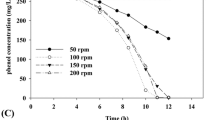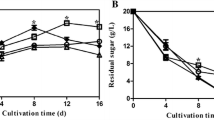Abstract
Jiangxienone produced by Cordyceps jiangxiensis exhibits significant cytotoxicity and good selectivity against various human cancer cells, especially gastric cancer cells. In this work, the effect of nitrogen deficiency on the accumulation of jiangxienone and the transcription levels of jiangxienone biosynthesis genes was studied in submerged fermentation of C. jiangxiensis. Results showed that accumulation of jiangxienone was improved under nitrogen deficiency condition. A maximal jiangxienone content of 3.2 µg/g cell dry weight was reached at 5 mM glutamine, and it was about 8.9-fold higher than that obtained at 60 mM glutamine (control). The transcription levels of the biosynthetic pathway genes hmgr and sqs and the nitrogen regulatory gene areA were upregulated by 7-, 14-, and 28-fold, respectively, in culture with 5 mM glutamine compared to the control. It was hypothesized that the jiangxienone biosynthesis may involve the mevalonate pathway in C. jiangxiensis. Taken together, our study indicated that nitrogen deficiency is an efficient strategy for enhancing jiangxienone accumulation in submerged fermentation of C. jiangxiensis, which is useful for further understanding the regulation of jiangxienone biosynthesis.




Similar content being viewed by others
References
Paterson RR (2008) Cordyceps: a traditional Chinese medicine and another fungal therapeutic biofactory? Phytochemistry 69:1469–1495
Zhong JJ, Xiao JH (2009) Secondary metabolites from higher fungi: discovery, bioactivity, and bioproduction. Adv Biochem Eng/Biotechnol 113:79–150
Xiao JH, Sun ZH, Pan WD, Lü YH, Chen DX, Zhong JJ (2012) Jiangxienone, a new compound with potent cytotoxicity against tumor cells from traditional chinese medicinal mushroom Cordyceps jiangxiensis. Chem Biodivers 9:1349–1355
Liu ZY, Liang ZQ, Liu AY, Yao YJ, Hyde KD, Yu ZN (2002) Molecular evidence for teleomorph-anamorph connections in Cordyceps based on ITS-5.8S rDNA sequences. Mycol Res 106:1100–1108
Lü YH, Pan WD, Xiao JH, Sun ZH, Zhong JJ (2014) Cytotoxic mechanism of novel compound jiangxienone from Cordyceps jiangxiensis against cancer cells involving DNA damage response pathway. Process Biochem 49:697–705
Dou Y, Xiao JH, Xia XX, Zhong JJ (2013) Effect of oxygen supply on biomass and helvolic acid production in submerged fermentation of Cordyceps taii. Biochem Eng J 81:73–79
Xu JW, Xu N, Zhong JJ (2012) Enhancement of ganoderic acid accumulation by overexpression of an N-terminally truncated 3-hydroxy-3-methylglutaryl coenzyme A reductase gene in the Basidiomycete Ganoderma lucidum. Appl Environ Microbiol 78:7968–7976
Zhou JS, Ji SL, Ren MF, He YL, Jing XR, Xu JW (2014) Enhanced accumulation of individual ganoderic acids in a submerged culture of Ganoderma lucidum by the overexpression of squalene synthase gene. Biochem Eng J 90:178–183
Chen H, Yan M, Zhu J, Xu X (2011) Enhancement of exo-polysaccharide production and antioxidant activity in submerged cultures of Inonotus obliquus by lignocellulose decomposition. J Ind Microbiol Biotechnol 38:291–298
Wei ZH, Chen N, Li YJ, Fan QL, Yu TF, Wang KX, Dong BT, Fan EY, Yuan PL, Hu GW, Qiao F, Ge L, Deng YY, Lv YN, Hu BF, Liu L (2018) Glucose fed-batch integrated dissolved oxygen control strategy enhanced polysaccharide, total triterpenoids and inotodiol production in fermentation of a newly isolated Inonotus obliquus strain. Process Biochem 66:1–6
Wei ZH, Liu L, Guo XF, Li YJ, Hou BC, Fan QL, Wang KX, Luo Y, Zhong JJ (2016) Sucrose fed-batch strategy enhanced biomass, polysaccharide, and ganoderic acids production in fermentation of Ganoderma lucidum 5.26. Bioprocess Biosyst Eng 39:37–44
Xu X, Hu Y, Quan L (2014) Production of bioactive polysaccharides by Inonotus obliquus under submerged fermentation supplemented with lignocellulosic biomass and their antioxidant activity. Bioprocess Biosyst Eng 37:2483–2492
Lin S, Liu ZQ, Baker PJ, Yi M, Wu H, Xu F, Teng Y, Zheng YG (2016) Enhancement of cordyceps polysaccharide production via biosynthetic pathway analysis in Hirsutella sinensis. Int J Biol Macromol 92:872–880
Wang LY, Cheong KL, Wu DT, Meng LZ, Zhao J, Li SP (2015) Fermentation optimization for the production of bioactive polysaccharides from Cordyceps sinensis fungus UM01. Int J Biol Macromol 79:180–185
Sari N, Suparmin A, Kato T, Park EY (2016) Improved cordycepin production in a liquid surface culture of Cordyceps militaris isolated from wild strain. Biotechnol Bioproc Eng 21:595–600
Asai T, Yamamoto T, Oshima Y (2012) Aromatic polyketide production in Cordyceps indigotica, an entomopathogenic fungus, induced by exposure to a histone deacetylase inhibitor. Org Lett 14:2006–2009
Xiao JH, Chen DX, Liu JW, Liu ZL, Wan WH, Fang N, Xiao Y, Qi Y, Liang ZQ (2004) Optimization of submerged culture requirements for the production of mycelial growth and exopolysaccharide by Cordyceps jiangxiensis JXPJ 0109. J Appl Microbiol 96:1105–1116
Xiao JH, Chen DX, Wan WH, Hu XJ, Qi Y, Liang ZQ (2006) Enhanced simultaneous production of mycelia and intracellular polysaccharide in submerged cultivation of Cordyceps jiangxiensis using desirability functions. Process Biochem 41:1887–1893
Choi JH, Ogawa A, Abe N, Masuda K, Koyama T, Yazawa K, Kawagishi H (2009) Chaxines B, C, D, and E from the edible mushroom Agrocybe chaxingu. Tetrahedron 65:9850–9853
Barbet-Massin C, Giuliano S, Alletto L, Daydé J, Berger M (2015) Nitrogen limitation alters biomass production but enhances steviol glycoside concentration in stevia rebaudiana bertoni. Plos One 10:e0133067
Zhou X, Zhong JJ (2009) Effect of initial ammonium concentration on taxoid production and biosynthesis genes expression profile in suspension cultures of Taxus chinensis cells. Eng Life Sci 9:261–266
Munoz GA, Agosin E (1993) Glutamine involvement in nitrogen control of gibberellic acid production in Gibberella fujikuroi. Appl Environ Microbiol 59:4317–4322
Zhao W, Xu JW, Zhong JJ (2011) Already-enhanced production of ganoderic acids in static liquid culture of Ganoderma lucidum under nitrogen-limiting conditions. Bioresource Technol 102:8185–8190
Rodriguez-Ortiz R, Limon MC, Avalos J (2009) Regulation of carotenogenesis and secondary metabolism by nitrogen in wild-type Fusarium fujikuroi and carotenoid-overproducing mutants. Appl Environ Microbiol 75:405–413
Marzluf GA (1997) Genetic regulation of nitrogen metabolism in the fungi. Microbiol Mol Biol R 61(1):17–32
Shang F, Wen S, Wang X, Tan T (2006) Effect of nitrogen limitation on the ergosterol production by fed-batch culture of Saccharomyces cerevisiae. J Biotechnol 122:285–292
Fabregas J, Dominguez A, Alvarez DG, Lamela T, Otero A (1998) Induction of astaxanthin accumulation by nitrogen and magnesium deficiencies in Haematococcus pluvialis. Biotechnol Lett 20:623–626
Solovchenko AE, Khozin-Goldberg I, Didi-Cohen S, Cohen Z, Merzlyak MN (2008) Effects of light and nitrogen starvation on the content and composition of carotenoids of the green microalga Parietochloris incisa. Russ J Plant Physiol 55:455–462
Brzonkalik K, Hummer D, Syldatk C, Neumann A (2012) Influence of pH and carbon to nitrogen ratio on mycotoxin production by Alternaria alternata in submerged cultivation. AMB Express 2:28
Lopez JLC, Perez JAS, Sevilla JMF, Fernandez FGA, Grima EM, Chisti Y (2003) Production of lovastatin by Aspergillus terreus: effects of the C: N ratio and the principal nutrients on growth and metabolite production. Enzyme Microb Tech 33:270–277
Xu JW, Xu YN, Zhong JJ (2010) Production of individual ganoderic acids and expression of biosynthetic genes in liquid static and shaking cultures of Ganoderma lucidum. Appl Microbiol Biotechnol 85:941–948
Hayashi H, Huang PY, Inoue K (2003) Up-regulation of soyasaponin biosynthesis by methyl jasmonate in cultured cells of Glycyrrhiza glabra. Plant Cell Physiol 44:404–411
Todd RB, Fraser JA, Wong KH, Davis MA, Hynes MJ (2005) Nuclear accumulation of the GATA factor AreA in response to complete nitrogen starvation by regulation of nuclear export. Eukaryot Cell 4:1646–1653
Langdon T, Sheerins A, Ravagnani A, Gielkens M, Caddick MX, Arst HN Jr (1995) Mutational analysis reveals dispensability of the N-terminal region of the Aspergillus transcription factor mediating nitrogen metabolite repression. Mol Microbiol 17:877–888
Wiemann P, Willmann A, Straeten M, Kleigrewe K, Beyer M, Humpf Hu, Tudzynski B (2009) Biosynthesis of the red pigment bikaverin in Fusarium fujikuroi: genes, their function and regulation. Mol Microbiol 72:931–946
Li J, Pan Y, Liu G (2013) Disruption of the nitrogen regulatory gene AcareA in Acremonium chrysogenum leads to reduction of cephalosporin production and repression of nitrogen metabolism. Fungal Genet Biol 61:69–79
Acknowledgements
This research was supported by the National Nature Science Foundation of China (Nos. 21566016, 81660363), and the Guizhou High-Level Innovative Talent Support Program (No. QKH-RC-20154028).
Author information
Authors and Affiliations
Corresponding authors
Ethics declarations
Conflict of interest
We declare that we have no conflict of interest.
Rights and permissions
About this article
Cite this article
Jiang, LX., Han, LL., Wang, HP. et al. Improved production of jiangxienone in submerged fermentation of Cordyceps jiangxiensis under nitrogen deficiency. Bioprocess Biosyst Eng 41, 1417–1423 (2018). https://doi.org/10.1007/s00449-018-1970-8
Received:
Accepted:
Published:
Issue Date:
DOI: https://doi.org/10.1007/s00449-018-1970-8




